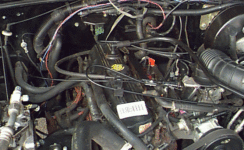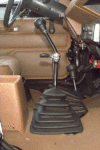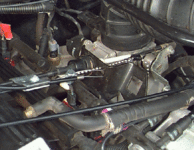Once you’ve filled your engine compartment with all kinds of pulley-powered goodies (like a York air compressor or a Premier Power Welder), you’ll find yourself wanting to adjust the speed at which the engine turns without having to sit with your foot on the accelerator. Also, when crawling slowly over bumpy terrain, you’ll sometimes have a hard time keeping your foot steady on the accelerator, and wish you could fix your speed via some other means.
The solution to both these problems is to install a hand-operated throttle control lever. Rubicon Express used to make a kit to install one of these for $30, and Jeff Yokomura wrote a good description of the installation process on his ’92 Wrangler [no longer active]. However, being the cheap-skate that I am, I opted to build one myself similar to what Jon Hylands did. I stopped by a bike shop and picked up a shifter handle, 6 feet of brake/shifter cable, and 6 feet of cable housing for $15. I also scavenged a few inches of ball-chain that was left over from my cruise control kit. The whole thing took me about 2 hours.
The first step is to run the cable. Remove the 8 or so screws that hold the tranny/t-case upper shift boot in place and raise the boot up a few inches so you can see the lower boot. Shove one end of the cable housing through both boots, right next to the shift lever (tranny if you’ve got it, otherwise t-case). Getting it through the lower boot took some work–I ended up pushing it through almost horizontally to clear some of the hardware that’s right below the boot.
Feed the housing under the body tub above the transmission and up along the firewall to the top of the engine. Route it as necessary to reach your throttle linkage, making sure to keep it away from hot stuff that may burn through it. A few zip ties will keep it in place. If you’ve got extra cable or housing, don’t cut it to length until you’re nearly finished with the installation and are sure of just how long you’ll want it.
The second step is to clamp the throttle handle in place. I found the most convenient spot to be on the passenger side of my tranny shift lever, right where it bends. In order to get the provided clamp to grab hold, I had to build up the thickness of the shift lever by wrapping 1-inch strips of an old rag around the lever and then holding them in place with an attractive layer of black electrical tape. (David Russ later told me that a 1″ length of 1/2″ ID heater hose also worked well.) Feed the cable housing up into position next to the handle, and then fix it in place against the shift lever with a couple rounds of electrical tape. You can now screw the shifter boot back in place.
The difficult part was getting the cable connected to the throttle linkage and adjusted appropriately. If you haven’t already, feed the cable itself through the handle and the housing so that you’ve got at least 3 inches or so sticking out past the end of your cable housing. Don’t connect the cable directly to the throttle linkage. This will make it more difficult for the factory throttle control (or your cruise control, if an aftermarket unit was installed) to adjust the throttle linkage. Instead, it’s best to connect the cable to the linkage via a short chain or something that will easily give up slack when the engine tries to accelerate beyond where the hand throttle is set to. I used a few inches of ball chain that I scavenged from my aforementioned cruise control system. You’ll want to attach this in a way that will allow you to adjust the length of the cable and the position of the hand throttle.
That’s all the installation; now you’ve got to test and fine-tune it. Pull the hand throttle all the way back (lowest idle speed) and start your engine, then wait until the engine drops to its normal idle speed. Slowly push the lever upward until the engine speed starts to increase. Note the lever position. Slowly advance the lever until the engine is at a high speed somewhere below red-line, and note the position of the engine’s throttle linkage. Turn off the engine. As a safety feature, you’ll probably want your lever to max out before your engine reaches an unsafe speed. This may mean that the lever must move quite a bit at the low end before it starts affecting the engine speed. Adjust the cable’s connection to the throttle linkage so that the lever position and engine speed are the way you want them, then go out and have fun!
Do you like this site?
Help me keep it going by throwing a few pennies my direction.
![]()
![]()
![]()
![]()
Links on this page to Amazon are part of an affiliate program that helps keep Jedi.com operational.
Thank you for your support!



